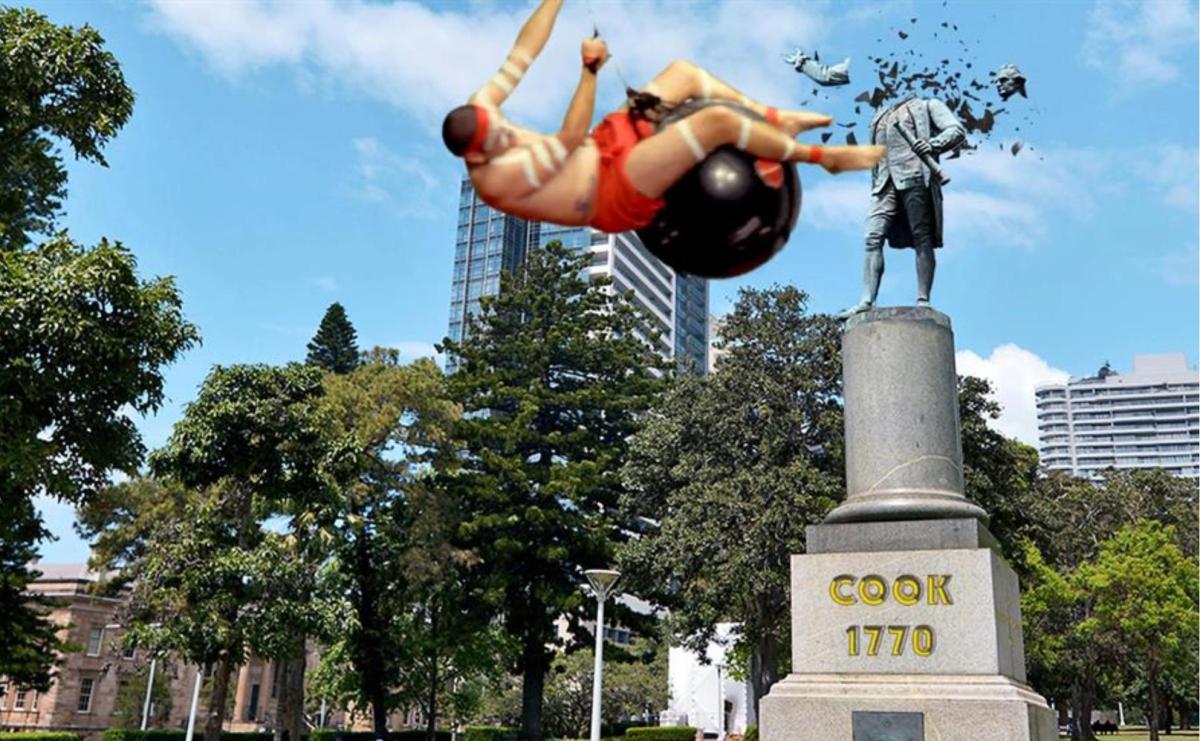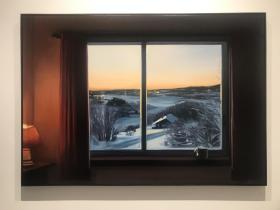2020 was a big year. It was not the year we expected as a visual arts sector, but on the up-side, it was one that forced a rethink on many levels – some bringing a bonus to the visual arts, especially through digital platforms, access, increased online sales, and artist commissions.
That sense of a seismic smashing of the ‘old normal’ is perhaps best captured in Tony Albert’s video work, You Wreck Me (2020), commissioned during the pandemic by Institute of Modern Art in Brisbane (pictured above).
It captures a rethinking of our Captain Cook narrative, tapped the global zeitgeist of Black Lives Matters protests in 2020 and local trigger points around First Nations conversations, while also questioning public art and historical monuments, and what a pandemic might look like for artists – to try to stay in balance, to progress forward and to do it gracefully when there is no rule book.
These are the big topics and trends that stood out in 2020
Biggest rethink: The 250th anniversary of Captain James Cook’s navigation was somewhat overshadowed by COVID. For many that was OK. The milestone in this conversation for 2020 was how institutions faced this narrative, many inserting a First Nations lens. We took a look at that: Cook through the eyes of five curators.
Biggest unveil: The long-awaited reveal was shared this year by the Western Australian Museum – a $400 M project, and the Chau Chak Wing Museum, located on the campus of Sydney University. Both opened in November. A cheers should also be thrown the way of the Hyde Park Barracks, the Australian Museum and NorthSite Contemporary Arts in Cairns, which all re-opened after major refurbishments in 2020, enriching the visitor experience.
Big newbies: Opening in May, the City of Sydney announced the latest cultural asset to join the national landscape would be a new museum to preserve Chinese history and culture in Australia, to be known as the Museum of Chinese in Australia (MOCA). While from a gallery perspective, NSW set to develop its newest regional gallery – Ngunungulla – or the Southern Highlands Gallery in Bowral, which turned sod this month for a 2021 delivery.

Nyurpaya Kaika Burton, Ngayuku tjukurpa, mara walytjangku palyantja – My story, written in my own hand 2020, Amata, South Australia. Courtesy the artist and Tjala Arts. © Nyurpaya Kaika Burton/Copyright Agency
Big First Nations: In 2020 the Bla(c)k Lives Matter (BLM) movement found currency in Australia following protests in America. But Australia also had its own talking points for change in 2020 for First Nations artists:
- New Centre for Truth Telling gives home to Stolen Generations at Curtin University (WA)
- The first festival to be presented post-COVID was the Aboriginal-led Parrtjima festival
- Working with 87 artists during the pandemic and remote lockdowns, Tarnanthi continues to be innovative, and in a first, threw the spotlight on the work of women Aboriginal artists.
- Vincent Namatjira wins this year’s Archibald Prize, first Aboriginal artist in 99 years, while Dennis Golding was the first Indigenous artist to be awarded the NSW Visual Arts Fellowship in its 24-year history
- The Federal Government launched a Consultation Paper and called for submissions to an Indigenous Visual Arts Action Plan to reshape the future of the sector and its economic viability post-pandemic.
- TIWI at NGV, traces Tiwi art across time and across media, from 1911 to now – the largest to ever address this work to date.
- Australia Council released new Protocol updates for First Nations Cultural and Intellectual Property
- AGENCY – a New org pairing philanthropy with Indigenous artists was established
- Indigenous designers gave mainstream Australian fashion bang for its buck, through Piinpi at Bendigo Art Gallery
- Worthy of the gong of the biggest keynote speech in 2020, Decolonising Feminism: A First Nations perspective was part of NGA’s know my name conference.
- Budget delivers $10 million to bring Indigenous cultural items back home, with funding going towards establishing connections with overseas collectors and item holders, maintaining a database of identified items, as well as supporting handover ceremonies held on Country.
The biggest “WHAT THE?!*@!”: While I feel like the disappearance of the Commonwealth Department of the Arts should fall in this year (it was announced 23 December as arts orgs closed for the holidays), this category has to go to Sydney’s Cockatoo Island, which for a short moment in 2020 was entertaining to take up the offer of $80 million from a private consortium to turn the island into an art-filled tourist attraction, along the lines of Japan’s Naoshima art island. The idea was quickly quashed in March.
Biggest turn around: It would have to be the resignation and then reappointment of NSW Arts Minister Don Harwin, as the most sensational flip of events in 2020. Forced to resign for breaking COVID restrictions in April, NSW Premier Gladys Berejiklian stepped in (albeit it briefly and with no impact), only to reinstate Harwin 3-months later.Biggest fake: It is amazing how, in past years it was a fake by artists Brett Whiteley or Albert Tucker that made it to the courts, and yet this year Parliament again knocked back changes to Fake Aboriginal Art legislation, despite years of work advocating for better protections.
Biggest art fair: All went virtual this year, kicking off with Melbourne Art Fair Viewing Rooms and Cairns Indigenous Art Fair, as well as Desart, Sydney Contemporary and Tarnanthi. While the outset of the year looked incredibly bleak with art fairs globally decimated by COVID, by the time Australia rolled out its suite of fairs we had worked out it was a great way to support artists during the pandemic, and build audiences beyond physical boundaries. Results were overwhelming positive despite the circumstances.

Carriageworks. Image Guy Louden. Guy write a great story for ArtsHub this year on casual workers remaining exposed.
Biggest phoenix: The visual arts and performing sectors reeled this year with the news that Carriageworks had moved into administration. It was the dedication of philanthropists, however, that turned the tables with a financial commitment which eventually led to the multi-arts venue securing a 20-year lease and a five year funding commitment from the NSW Government.
Biggest staff cuts: Director National Gallery of Australia (NGA) Director Nick Mitzevich, faced the tough job of advising around 30 staff would be offered voluntary redundancies with the need to reduce the staff load by 10%. (June). The reason for the cuts is the knock-on impact of ongoing efficiency dividends implemented by the federal government, failing interest rates impacting income, and rising utility costs. It is a funding shortfall that sits around $1.5 million a year.
The big furore: In May, Skye O’Meara, Manager of APY Art Centre Collective (APYACC) told ArtsHub she was witnessing a rise again in carpetbaggers, opportunists, white traders threatening the livelihood of Aboriginal art centres. Why? A spike in international interest in Aboriginal art is forging new highs.
Biggest win: Many in the visual arts and museum sector would agree that one of the biggest wins of 2020, was confirmation in July that Powerhouse Museum will retain the Ultimo site (in part) for a museum of fashion and design. This has been the result of years of lobbying. In July NSW Premier Gladys Berejiklian announced that the Ultimo site would be spared from sale for commercial and residential towers, and forego the $195 million price tag.
Big design: While DESIGN Canberra and the new Craft Contemporary festival in Victoria deserve a solid nod, this year leading fresh design conversations was Piinpi: Contemporary Indigenous Fashion, presented at Bendigo Art Gallery. Two years in the making, and with a delayed opening due to COVID-19, the exhibition moves across the collections of 70 artists and designers.
Biggest battle of words: Sydney’s Museum of Contemporary Art Australia (MCA) pushed back against a former staff member’s claims about discrimination and racial harassment in 2020. In a post published on Medium, Chinese-Australian artist Lilly Lai argued the MCA failed to properly handle reports of ‘blatant racism or verbal abuse from visitors’, and lacked policies to protect people of colour.’
In a statement, Director of the Museum of Contemporary Art, Elizabeth Ann Macgregor advised ‘MCA staff are treated fairly and equitably with all incidents taken very seriously and investigated in line with MCA policies,’ adding that the organisation was ‘especially proud of our front of house team’. Macgregor herself takes her turn on the front desk during the year.
Biggest gallery closure: While many visual arts organisations and museums temporarily closed their doors in 2020 as an impact of Coronavirus, there was one organisation that did so for good (well for now). Australian Centre for Photography (ACP) goes into hibernation, rather than administration.
Big policy, but not such big outcomes: This year the Resale Royalty Scheme turned ten. A Review Report of the Resale Royalty Right for Visual Artists Act was tabled ahead of that anniversary, which read as both outdated and opaque, only fuelling confusion around the program.
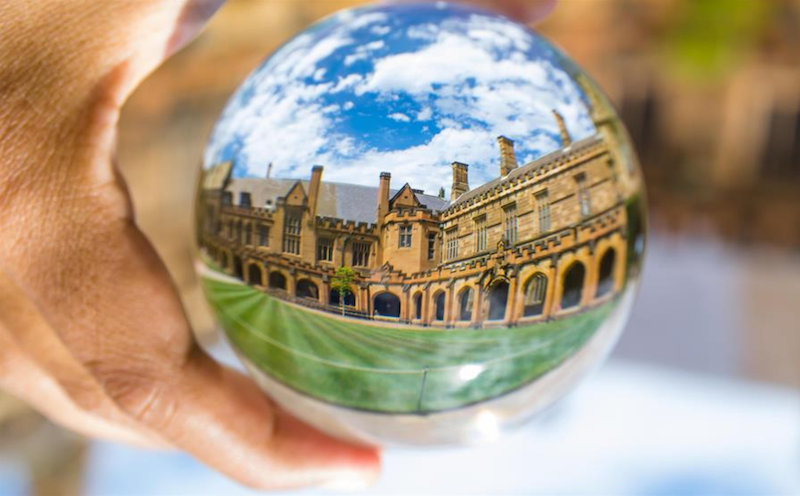
Image shutterstock.
Big education news (the good): Despite a year that saw huge knocks to visual arts education nationally, there were also a few moments to celebrate:
- Rejecting silo-thinking across art and craft disciplines, and dispelling the myths of waning support, Sydney College of the Arts opened with an optimistic future.
- The National Art School received $18M from NSW government for refurbishments.
- A new National Drawing Centre brings Australia in line with global trend
- The Queensland College of Art Griffith University appointed its first female director, Professor Elisabeth Findlay – the first time a woman has held the top post since the College was established in 1881.
Big education news (the bad): Sadly, the good news was overshadowed by the bad in 2020, as arts education institutions battled a loss of international students, humanities fee cuts, and restructuring to recoup mushrooming deficits. Hardest hit were Queensland College of Art at Griffith University(QLD) and the School of Art and Design at Australian national University (ACT).
Biggest appointment: While we might point to the appointment of the new ACT Arts Minister, Tara Cheyne MLA; or to Chris Keely, who stepped in the shoes of Executive Director for Create NSW, we have given this gong to Colin Walker, who takes the helm as Director at Art Gallery of WA – one of few State galleries – despite never holding a gallery directorship before.
Big solos: Surprisingly, with many of our galleries closed for extended period in 2020, there was still a solid roll out of major survey exhibitions by Australian artists this year – which felt more critical than ever before. Among them were:
- Destiny Deacon, NGV Australia
- Ivant Durant: Barrier drawn also at NGV Australia
- Unfinished Business: The Art of Gordon Bennett (QAGOMA)
- Mavis Ngallametta: Show me the way to go Home (QAGOMA)
- Pat Larter: Get Arted at AGNSW
- Lindy Lee – Moon in a Dew Drop, Museum of Contemporary Art. Read Review.
- Streeton, Art Gallery of NSW. Read Review.
- Vernon Ah Kee: The Island, Campbelltown Arts Centre (NSW). Read Review.
- the moment eternal: Nyapanyapa Yunupiŋu, at Museum and Gallery NT
Biggest gender re-balance: Know my name was more than an exhibition; it was also a conference, a national billboard project, a publication, and a sweet of small shows all presented by the National Gallery of Australia in a decisive move to address its historic collecting habits and failing gender equity. Prior to the project percentage of women exhibited (not only collected) by the NGA had fallen just 25 per cent, and falling. Of the 350+ artworks across the project, 20% was commission and acquired to grow the Collection.
Biggest censorship of sorts: In October, what was described as an ‘extraordinary intervention’, the Australia Council for the Arts has rescinded a $25,000 grant for performance artist Casey Jenkins’ artwork IMMACULATE, citing ‘the potential legal risk [the project] presents’. The project was a documentation of their attempt to conceive via self-insemination.
Big rebrand: From January 2020, Sotheby’s Australia became Smith & Singer, with the auction house reaching the end of a ten-year licensing agreement with Sotheby’s. The name is drawn from co-owners Gary Singer and Geoffrey Smith.
Biggest public art: This was not only national, but international. In the wake of BLM protests in America, 2020 was marked by the toppling of colonialist public sculptures in a “righting” of history. We took a look at how divided readers were on removing Australians sculptures. While some artists took to the streets in protest, others made work. A great example which captured the spirit of 2020, was Tony Albert’s video, You Wreck Me (2020) commissioned by IMA, Brisbane (pictured top).
Biggest faux pas: With the close of 2019, we all expected this would be sorted, but in July, solvency records showed that the inaugural Biennale of Australian Art (BOAA), which was presented in Ballarat, owed around $350,000 to artists and vendors. Its former director continues to try to repay debts to artists, and has moved on to open a new gallery.
Biggest kids show: Well not just for kids. In an Australian first, QUT Art Museum brings Miffy – the iconic minimalist design created by Dutch illustrator Dick Bruna, and looks at his influence on artists in Australia, and all over the world.

Van Gogh Alive, Royal Hall of Industries 2020, Sydney. Photo: ArtsHub.
Biggest tech bling: While we all have our tech milestone moment in 2020, the gong for the biggest pull-off is Van Gogh Alive, presented at The Royal Hall of Industries in Sydney – and a savvy rethinking of promoters M Agency. While the hard-nosed critic might be dismissive of this blockbuster for its ‘cheesy’ popularism and big splash spectacle, the flipside was that this experience fills one with light, with joy when audiences most needed it in a COVID-safe way. The trick was not expecting it to be a Van Gogh exhibition.
Biggest disrespect: It was not only a national disgrace, but an international one, as media picked up on the destruction of Aboriginal sites by big mineral and mining companies, including a rock shelter in Juukan Gorge blown up by Rio Tinto in May. Read: In Depth: Mines Versus Aboriginal Culture
Biggest international move: The cancellation of artist residencies was a biggie in 2020, along with exhibitions with international travel grounded, and most international blockbusters cancelled. There was one event that pulled through that caught our eye – Largest Aboriginal art exhibition travels to Europe, despite pandemic mayhem. We also took a look at ‘Pandemic travel for artists’ in our ArtsHubbub podcast.
Biggest debate: Hotly debated this year, was the re-painting of Melbourne’s iconic Hosier Lane in February. Read: Is the Hosier Lane attack vandalism or street art?
Biggest court case: In March, One of Australia’s most celebrated street artists, Anthony Lister, was charged with multiple counts of alleged sexual assault and non-consensual tattooing of a woman, with his current exhibition cancelled.
The big good: The Australian Visual Artists’ Benevolent Fund has been around for about 30 years, but it was in the wake of COVID that it was reinstated this year. In part driven by artists themselves, the National Association of Visual Artists (NAVA) is again administering the fund and spearheaded new fundraising to assist artists in crisis.
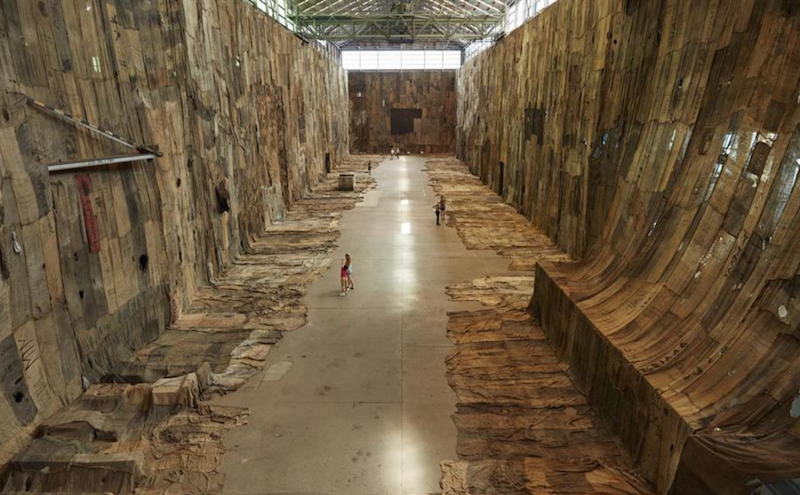
Ibrahim Mahama, No Friend but the Mountains 2012-2020, charcoal jute sacks and mixed media. Installation view (2020) for the 22nd Biennale of Sydney, Cockatoo Island. Courtesy the artist; White Cube and Apalazzo Gallery. Photo: Zan Wimberley.
Biggest Biennale: It goes within a flutter of doubt that NIRIN: 2020 Biennale of Sydney curated by Brook Andrew had a seismic impact in the conversations blockbusters exhibitions could broach, with many claiming it was the First Nations biennale we needed to have. Read Review.
But others that deserve a massive nod also, to have pulled off such strategically complex exhibitions when freight is difficult and installation has been manage via zoom meetings include:
- The Inaugural Bankstown Biennale
- Monster Theatres – 2020 Adelaide Biennial, Art Gallery of SA. Read Review.
- Why the NGV Triennial is the exhibition we need now (opening 19 December)
- Real Worlds – Dobell Drawing Biennial (AGNSW). Read Review.
- Tarnanthi – the festival celebrating the art and culture of Aboriginal and Torres Strait Island artists at the Art Gallery of South Australia
Read: Glocalism: COVID inspires the local blockbuster
Biggest market shifts: While many will say COVID has been bad for business, many art gallerists, craft and design shops, and small bespoke art business, will say the online pivot was a boon. Isolation changed the face of arts e-commerce in 2020. Many auction houses reported new highs with sales (including the sale of a Brett Whiteley painting that broke Australian art auction records, selling for $6.136 million); Lloyds Auctions (Australia) reported a spike this year exceeding expectations selling millions of dollars of fine art and jewellery each month. Lloyds Auctions were initially conducting 10 online certified art auctions per month in Australia however that number has increased recently by 500%. Sales of craft and design saw a new all-time high demand, and we spoke the commercial gallery dealers on how collectors stood up.Big value shift: A new Survey Report shows that Australian University Art Museums punch well above their weight scale, and are growing in strength, despite the challenges universities face.
Biggest thumbs up: The polls came in this year. The most popular exhibition (judged by daily visitor count) was Quilty at Queensland Art Gallery / Gallery of Modern Art (QAGOMA) with 2,914 visitors daily or 311,846 over the exhibition period. The exhibition was curated by the Art Gallery of South Australia. The second most popular exhibition was also presented by QAGOMA, Margaret Olley: A Generous Life, which had a higher overall attendance (showing longer with 339,128) but a daily average of 2803. In a funny twist, Quilty’s Archibald winning portrait was of Margaret Olley.
Biggest “stinky” restructure: While the ANU School of Art and Design is a big contender for this gong, it is one that is still playing out, and I suspect more on the topic to hit the table. It was an event earlier in the year however, that is worthy of mention. Parallel to the many protests the arts was witness to in 2020, it was one that was student-led that hit hardest. UNSW’s dismissal of Director of Indigenous Programs at UNSW Art and Design, Tess Allas in 2019, led to the #StandWithTess campaign. By July this year, the University’s Vice Chancellor announced that, ‘The School of UNSW Art & Design will move into a larger and soon to be established Faculty with the working title of Arts, Architecture and Design. Other Schools joining this new Faculty are Built Environment, and the four Schools of the Faculty of Arts & Social Sciences.’ The question lies in two words: ‘swallowed up’? It would seem art schools have entered a new breed.
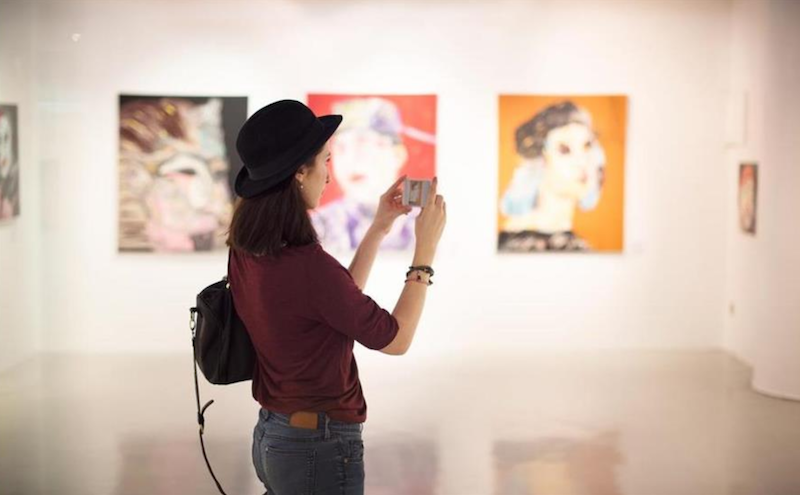
Image shutterstock.
Biggest report: While the Federal Government’s Parliamentary Inquiry into the impact on the arts during COVID-19 is clearly the big one for 2020, drilling down on the visual arts it was a report released in June – the Australian Public Galleries Snapshot – that was hopeful for the small to medium sector, which is supported by 16.5 million visitors annually. It was the first of its kind, and prepared by Museums & Galleries Queensland and Public Galleries Association of Victoria, with a commitment to long-term tracked results to aid advocacy.
Biggest effort: This goes hands down Tasmanian artist Lucienne Rickard with her Extinction Studies project for Tasmanian Museum and Gallery (TMAG) with draws to a close this summer, culminating in a final erasing as part of the Mona Foma festival program in Hobart in late January.
Lucienne has been at TMAG since September 2019, drawing and then erasing a newly-extinct species on her large sheet of paper in the Link Foyer. Her final creation will be erased on Sunday 24 January 2021.
Biggest bureaucratic headache, and biggest delay: You guessed it – the Powerhouse Museum’s move to Parramatta takes this gong, for another year running (aren’t we tired yet of this broken record?) In 2020, the site proposed for the new museum experienced heavy rains leading to the exposure (or should I say “leak”) that 20-year flood mapping showed the future museum would be in jeopardy. Apparently the design by architectural team, French practice Moreau Kusunoki and Australia’s Genton, is back on the table for tweaks.
Just a couple of weeks earlier (23 March), a further Upper House Select Committee had been announced – the Inquiry into the Government’s management of the Powerhouse Museum and other museums and cultural projects in New South Wales (submissions closed May).
Then in June, the NSW branch of the Construction, Forestry, Maritime, Mining and Energy Union (CFMEU) placed a green ban on the site of the proposed Powerhouse Parramatta, adding industrial weight to the grassroots campaign to save two state heritage listed buildings. A Parliamentary report in 2017 noted that the final cost of moving the Powerhouse may be up to $1.5 billion. Currently, the new museum is slated to open in 2024.
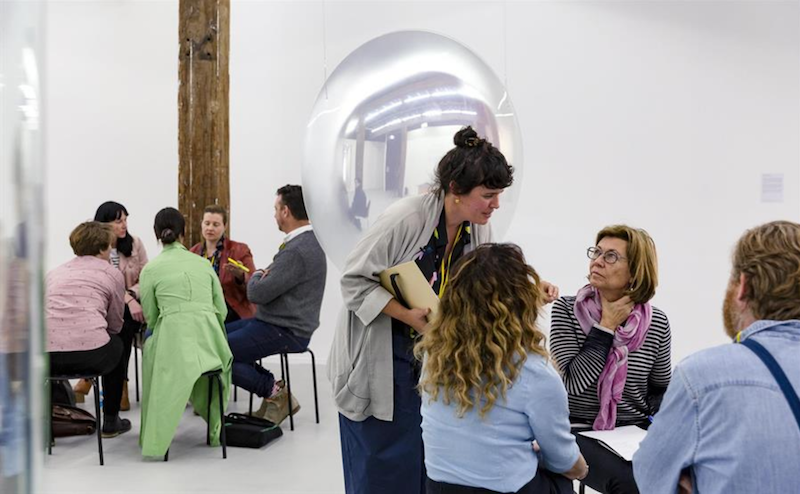
Marion Buchloh-Kollerbohm leading the Cultural Mediation in Practice, featuring Mel O’Callaghan’s exhibition Centre of the Centre. Photograph by Document Photography.
Big punch above weight: A new kit of resources produced by Museums & Galleries NSW promotes an understanding of cultural mediation, and offers the tools to arm staff and volunteers for deeper, sensitive audience engagement – and how to embed Cultural Mediation in their org. It is a free resource.
Biggest activity at the edges: While there were some wins – namely a National Centre for Photography for Ballarat, and an $10 million secured for Regional Arts Australia – it was a report that struck home in 2020, warning that many not-for-profit volunteer-run spaces won’t survive the pandemic – a group which makes up about 80% of public museums in NSW and QLD. Read story.
Sadly the story had an echo with the Australia’s Craft and Design, which is slowly being eroded away thanks to education cuts. Sector voices and peak bodies chose 2020 as a time to speak out.
Read: Celebrating milestone arts anniversaries during closure in 2020
Biggest security breach: Funny how mainstream media picked up on this one, but the visual arts sector just went ‘meh…’ In the height of COVID lockdowns (May), CCTV footage showed a man strolling through exhibits at the then closed Australian Museum and posing for selfies with his head inside mouth of T-Rex skull. The man turned himself in and was charged with breaking and entering. Clearly we were all missing our culture fix during COVID.